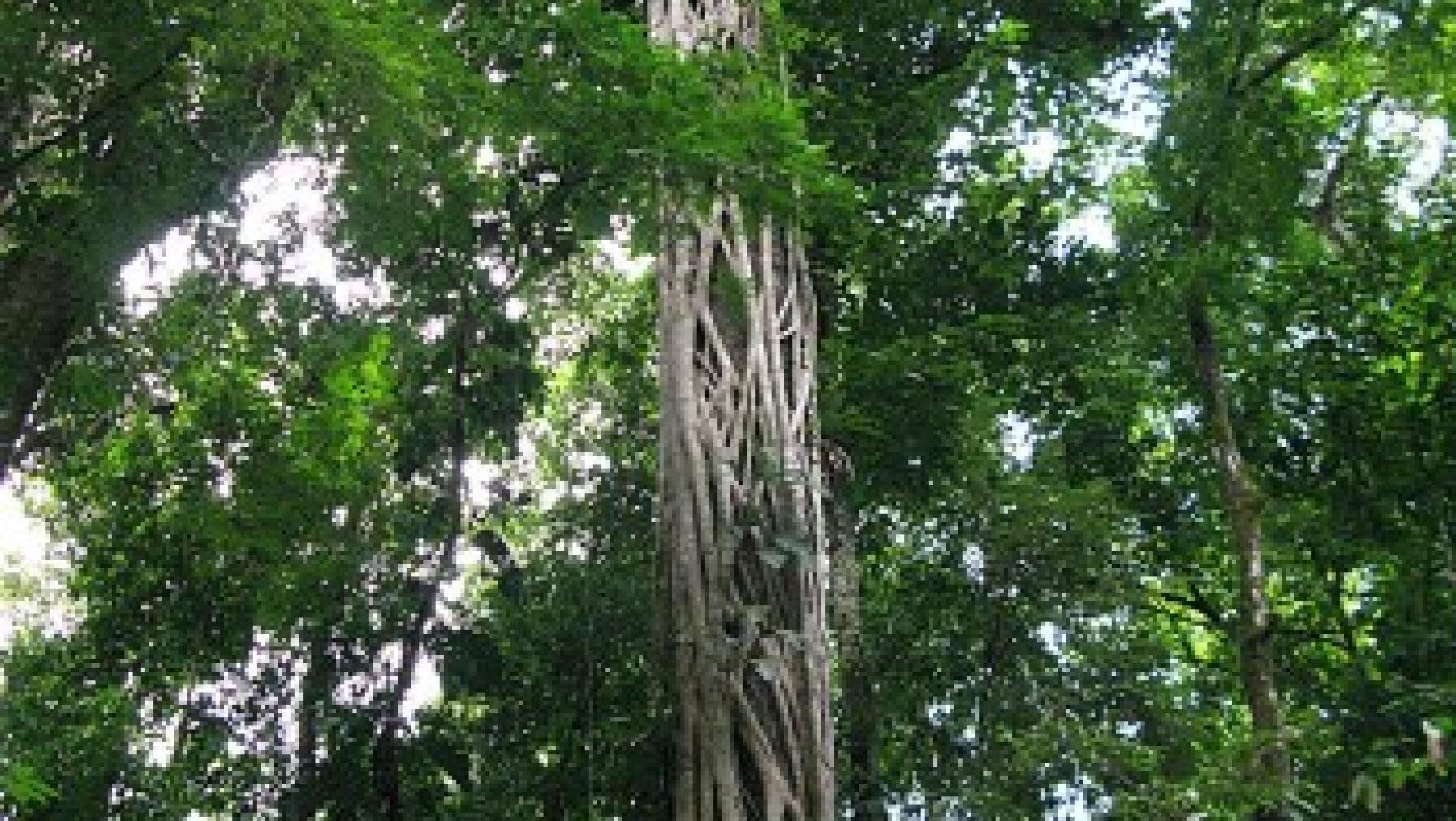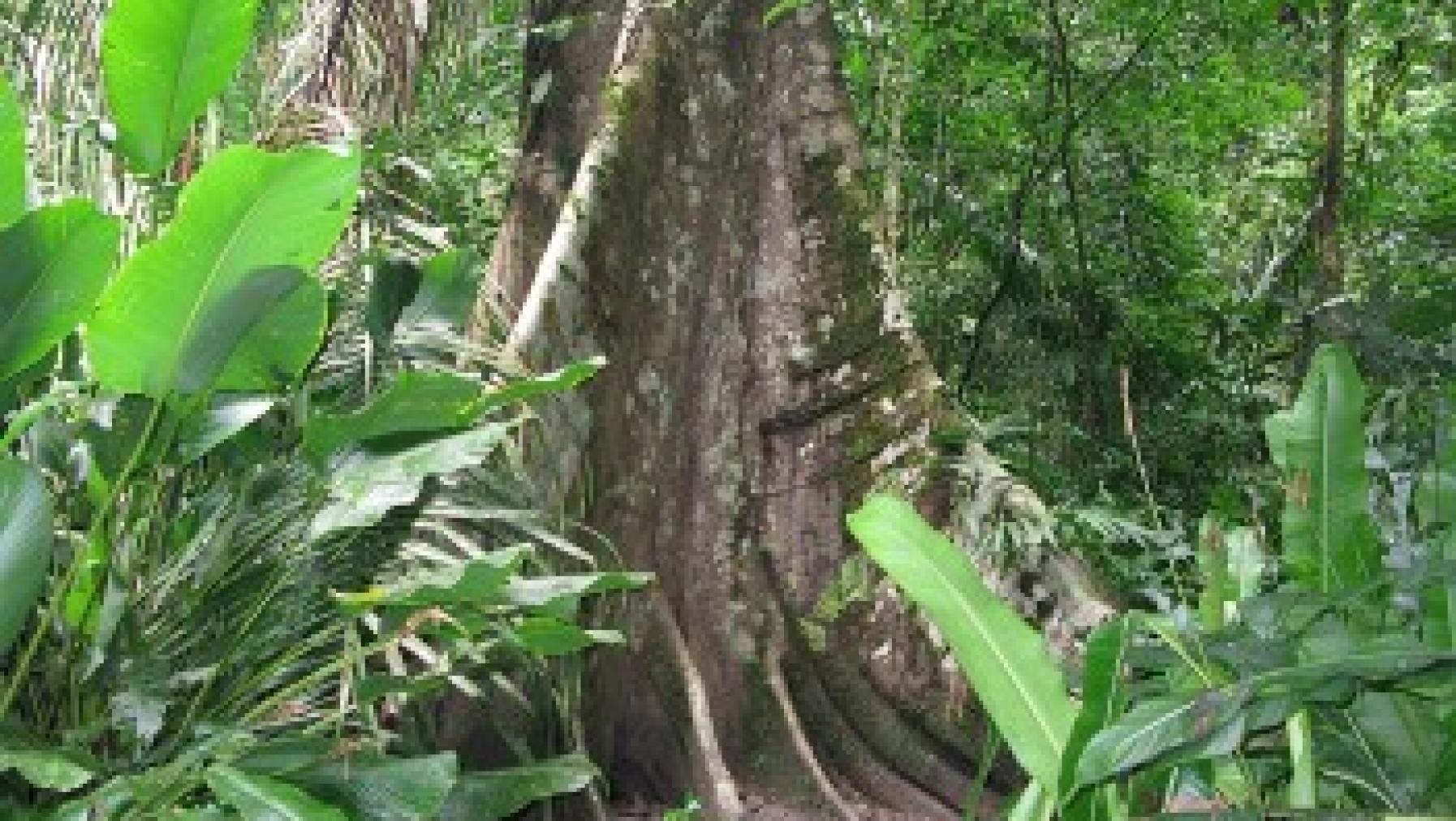Climate
Year-round high temperatures characterize the biome, with a daily temperature range exceeding the seasonal range. Day lengths are essentially the same year-round. Precipitation is seasonal, but it is seldom dry enough for drought stress. There are one or more relatively dry months (with less than 100 mm rainfall) almost anywhere in the zone, and few areas are wet throughout the year. The wet/dry seasons are associated with the movement of the thermal equator back and forth over the geographic equator, and this movement produces two rainy seasons within that zone. Strong winds are associated with storms or the dry season.
The microclimate is substantially different above and below the canopy, very significant to plants and insects.
Soils
Soils of this region are typically latosols. Chemical weathering is pronounced with high rainfall, thus soil profiles are deep, and there is little development of horizons below the shallow organic layer. Silica and other cations are carried away by leaching, leaving an acidic soil with high proportions of aluminum and iron oxides. The soil color is often reddish or yellowish-red. Under certain rainfall regimes, iron compounds become concentrated in a particular horizon ("laterite"), which may become hard and almost impervious to plant roots. Decomposition is very rapid, with organic material in the soil concentrated right at the surface and most nutrients retained in the above-ground biomass.
Vegetation
Tree growth is luxuriant, with emergent trees to 60 m and canopy trees to 30 m or more. The canopy is continuous except over water bodies and at windfalls ("gaps"). These are complex forests with as many as five moderately well-defined layers--emergents, upper canopy, lower canopy, understory and shrub/herb. Because of the dense leaf canopy, plant growth is suppressed and the undergrowth is relatively open in mature forest; the dense "jungle" of popular concept is associated with preclimax stages and gaps. Most plant species are evergreen, their leaves elliptic, often with an elongate ("drip") tip. Tree trunks are usually light-colored, straight and vertical, many with flaring buttresses; the bark is smooth and often patched with lichens. Lianas (large woody vines) are prominent. Epiphytes (growing on branches of other plants) reach their greatest development here, especially at slightly higher elevations, and epiphylls (growing on the leaves of other plants) are found only here. Decomposed plant material recycles almost instantly, so there is very little leaf litter.
Diversity
This zone has the highest plant diversity of any zone. There are thousands of species of trees, up to few hundred even in very restricted areas. Gymnosperms are rare, except cycads. Ferns and monocots are very diverse, many of them with tree form. Many of the tree species are in large families that are entirely or largely restricted to tropical forest areas, including Piperaceae, Moraceae, Annonaceae, Lauraceae, Capparidaceae, Leguminosae, Meliaceae, Anacardiaceae, Sapindaceae, Sterculiaceae, Guttiferae, Myrtaceae, Melastomaceae, Araliaceae, Myrsinaceae, Sapotaceae, Verbenaceae, Bignoniaceae, and Rubiaceae. The majority of large families are distributed throughout all the tropical continents. The Orchidaceae is one of the largest plant families, primarily epiphytic in this biome. Liana and vine families include Vitaceae, Leguminosae, Passifloraceae, Convolvulaceae and Cucurbitaceae. Oxalidaceae, Begoniaceae, Apocynaceae, Asclepiadaceae, Gesneriaceae, and Acanthaceae are important herbaceous families.
Animal diversity is also highest in this zone, with an almost incomprehensible variety of insects possible in a few hectares of rain forest. As in plants, many species are rare (few per unit area) and specialized. Large mammals are not diverse in primary forest, as locomotion is hindered by dense vegetation, but a few major orders (Chiroptera, Primates) are especially well represented. Other characteristic mammalian groups include tree shrews, squirrels, cavies, sloths, pangolins, forest deer and antelope, civets, and cats. Birds reach their greatest diversity in this zone, with over 500 species of birds recorded at single tropical localities of restricted extent. Characteristic groups include pigeons, parrots, hummingbirds, hornbills, toucans, ovenbirds, antbirds, cotingas, pittas, birds-of-paradise, babblers, bulbuls, and tanagers. Lizards, snakes, and frogs also exhibit their greatest diversity in the rain forest, including many groups restricted to it. Caecilians are a major amphibian group restricted to the tropics, mostly in forested areas. With so much water available, there is also a tremendous diversity of aquatic animals in this zone, although the temperate-to-tropical diversity gradient is not so extreme as in most terrestrial groups.
Plant Adaptations
With intense competition for light, many trees have the ability to remain semidormant under the canopy until a light gap appears, then undertake very rapid growth. Most of the light-receiving leaves in understory species are arranged in a single layer to avoid self-cast shade (monolayering). Epiphytes, epiphylls, and lianas all represent strategies for small plants to grow up higher where there is more light. Canopy leaves are leathery and drought-resistant to withstand severe sun intensity in this layer. Some leaves alter their orientation during the day to avoid sun stress; this is controlled by turgor pressure. Elongate leaf tips may serve to draw water off wet leaves, permitting respiration. New leaves in many plants are without chlorophyll (they look red or white) until they have grown to full size and have survived potential herbivore browsing. Extensive buttresses furnish support necessary because root systems are shallow, extending laterally to tap the surface layer of nutrients. Mycorrhizae (symbiotic fungal associations) in roots allow direct connection with the litter layer for efficient nutrient absorption. Pollination and seed dispersal are largely by animals, and interactions between plants and animals are very highly developed in this zone. Much pollination is by vertebrates and social bees, which travel long distances between scattered individuals of many plant species.
Animal Adaptations
Animals show year-round activity and very high diversity, thus interactions among species are intense. With the high diversity of predators, antipredator adaptations are maximally developed here. Camouflage is virtually perfect in the majority of smaller animals. Not only do brown and green predominate, but in some species the color changes with the background color. Background matching extends to shape as well as color; many insects, lizards, snakes, and frogs look like leaves, twigs or vines, down to amazingly fine details. Animals as different as clouded leopard and python have similar markings, and the same leaf type is mimicked by animals as different as katydids and chameleons.
A considerable portion of animal activity occurs in the canopy, where light is not limiting and plant productivity is maximized; in this complex landscape, adaptations for arboreality abound. Locomotory modes include climbing, jumping, brachiation, gliding, and flight. There are many specific adaptations such as sharp claws for climbing, opposed digits and prehensile tails for wrapping around branches and twigs, long hind legs for leaping, I-beam construction for rigidity, loose skin or skin fringes or expansible rib cages for gliding, and wings for flight in three major taxonomic groups.
The number of animal/plant interactions are maximal in this bioclimatic zone, with many complex adaptations to facilitate these interactions, which include not only destructive interactions such as herbivory but mutually beneficial ones such as pollination and fruit dispersal. Many of the major groups of flower-feeding birds (hummingbirds, sunbirds, flowerpeckers, honeyeaters) and mammals (pteropodid and glossophagine bats) are tropical, as are most fruit-eating birds and mammals. Arboreal species travel through the forest in search of fruiting trees (with learning the location of traditional trees), where much social interaction within and between species takes place. Earthbound animals benefit from the rain of edible fruit. Complex, often coevolutionary, interactions are commonplace, with high levels of mutualism and commensalism, including many of the most fascinating textbook examples.
Because of the high species diversity, some groups exhibit substantial "aspect diversity" (great differences in appearance), perhaps to counter predator search images and/or for quick species recognition.
Human Effects
The original hunter/gatherer populations had relatively little effect on the environment, but with population increase, especially with development of real population centers, they have hunted out a substantial proportion of large animals, especially conspicuous ones such as macaws and monkeys or rare ones such as cats. Hunting for "bush meat" is still a primary factor in rarity. Habitat destruction is usually the most serious problem, both by small-scale slash-and-burn agriculture and large-scale land clearing for ranching and farming. After a few episodes of clearing, soil loses essentially all its nutrients, becomes infertile and hard (laterization), and neither supports much plant growth nor acts as a water sink. Instead, erosion becomes a major problem, with much runoff of clays into streams and accompanying pollution.
Because of the tremendous diversity of tropical rain-forest species, the restricted range of many of them, and especially that so many of them are undescribed or scarcely known, habitat destruction is more serious in this biome than any other. Nowhere else is there such likelihood of widespread species extinction, much of which will happen unknown to us. Specific taxa still being depleted by hunting of individual animals include fur-bearing cats (most diverse in this zone), primates (much sought as food in some areas), and animals used as pets (e. g. parrots, fresh-water fish); stricter import regulations have alleviated but not prevented this.
A tremendous variety of tropical rain forest plants have been cultivated by humans. The high levels of secondary compounds in tropical plants have made them valuable as spices, stimulants, and other drugs, and many others are cultivated for food, clothing, and shelter. Recent discoveries indicate the potential value of tropical plants to humans has been scarcely realized.



